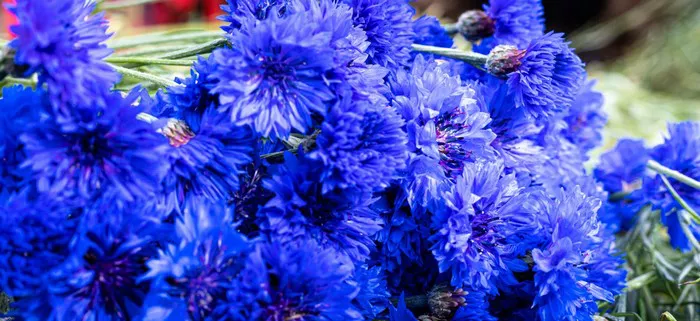Blue flowers, with their ethereal beauty and captivating hue, have long fascinated both gardeners and poets alike. Beyond their aesthetic appeal, these blooms carry deep symbolism and meaning across various cultures and contexts. From representing tranquility to expressing mystery, the symbolism of blue flowers is rich and diverse. In this article, we delve into the precise meanings associated with blue flowers, uncovering their significance in different aspects of human life and culture.
1. Calmness and Serenity
One of the primary associations with blue flowers is the sense of calmness and serenity they evoke. The cool, tranquil shade of blue is often likened to clear skies or peaceful waters, instilling a feeling of relaxation and harmony. Flowers such as the blue hydrangea, delphinium, and cornflower are emblematic of this serene quality, making them popular choices in gardens and floral arrangements meant to create a sense of peace and tranquility.
2. Trust and Confidence
Blue flowers are also frequently linked with attributes of trust and confidence. The color blue is commonly associated with reliability and dependability, qualities that are essential in fostering trust-based relationships. Giving someone a bouquet of blue flowers can convey a message of trustworthiness and faithfulness, making them a meaningful choice for occasions such as weddings or business engagements.
3. Symbolism of Hope
In many cultures, blue flowers symbolize hope and optimism for the future. The vibrant yet soothing hue of blue is often seen as a beacon of encouragement, reminding individuals to remain hopeful even in challenging times. Flowers like the blue iris and forget-me-nots are often used to convey messages of hope and encouragement, making them meaningful gifts for those going through difficult circumstances or embarking on new endeavors.
4. Depth and Mystery
Despite their association with tranquility, blue flowers can also carry an air of mystery and depth. The darker shades of blue, such as navy or indigo, evoke a sense of introspection and contemplation. Flowers like the blue poppy or morning glory, with their deep blue hues and intricate blooms, often symbolize mystery and the unknown, inviting individuals to explore the hidden depths of their own psyche or the mysteries of the natural world.
5. Spiritual Significance
In spiritual contexts, blue flowers are often associated with concepts of spirituality and enlightenment. The color blue has long been linked with the divine and the transcendent, representing higher states of consciousness and spiritual awakening. Flowers such as the blue lotus or blue orchid are revered in many spiritual traditions for their sacred symbolism, serving as reminders of the eternal quest for enlightenment and inner peace.
6. Symbol of Loyalty and Devotion
Blue flowers are frequently used to symbolize loyalty and devotion in romantic relationships. The steadfast nature of the color blue mirrors the unwavering commitment and fidelity found in enduring love. Giving a bouquet of blue flowers to a romantic partner can convey a message of loyalty and dedication, reaffirming the bond between two individuals and expressing enduring affection.
7. Inspiration and Creativity
Blue flowers are also associated with inspiration and creativity, making them popular choices for artists and writers seeking to tap into their imaginative faculties. The color blue is often linked with the vast expanse of the sky and the boundless depths of the ocean, evoking feelings of expansiveness and creativity. Flowers like the bluebell or gentian are said to inspire creativity and innovation, serving as muse-like symbols for those engaged in artistic pursuits.
8. Healing and Rejuvenation
In the language of flowers, blue blooms are sometimes associated with healing and rejuvenation. The calming properties of the color blue are believed to have a therapeutic effect on the mind and body, promoting relaxation and stress relief. Flowers such as the blue chamomile or lavender are prized for their soothing fragrance and medicinal properties, often used in aromatherapy and herbal remedies to promote overall well-being and vitality.
9. Expression of Gratitude
Blue flowers can also serve as a symbolic expression of gratitude and appreciation. The tranquil beauty of blue blooms is often seen as a reflection of the recipient’s virtues and qualities, making them a thoughtful gesture to convey heartfelt thanks. Whether given as a token of appreciation to a friend or as a gesture of gratitude to a mentor, blue flowers carry a message of acknowledgment and admiration for the recipient’s contributions and support.
10. Symbolism of Freedom
In some contexts, blue flowers symbolize freedom and liberation from constraints. The color blue is often associated with wide-open spaces and limitless horizons, evoking a sense of freedom and possibility. Flowers like the bluebell or blue anemone, with their delicate petals dan
cing in the breeze, symbolize the freedom to explore and pursue one’s aspirations without inhibition, inspiring individuals to break free from limitations and embrace new opportunities.
Conclusion
The symbolism of blue flowers encompasses a wide range of meanings, from tranquility and trust to mystery and spiritual enlightenment. Whether used to convey messages of hope and inspiration or to express sentiments of love and gratitude, blue flowers hold a special significance in human culture and imagination. As we continue to cultivate and appreciate these enchanting blooms, may we be reminded of the profound symbolism they carry and the myriad ways they enrich our lives.


